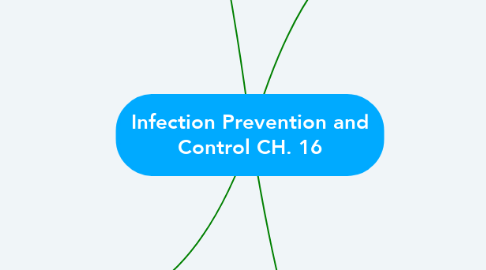
1. Infectious Agents
1.1. Bacteria- single cell microorganism.Classified according to their need for oxygen, their shape, and their gram-staining properties.
1.1.1. Aerobic-needs oxygen to grow and thrive.
1.1.2. Anaerobic-grow only when oxygen is not present.
1.1.3. Gram Positive-retains stains.
1.1.4. Gram Negative-losses the stain.
1.1.5. Morphology(shape)- Cocci(round), Bacilli(rod shaped), Spirochetes(Spiral), Streptococci(chains), Diplococci(pairs), Staphylococci(clusters).
1.2. Prions- protein particles.
1.2.1. Do not trigger an immune response.
1.2.2. Cause degenerative neurological disease.
1.3. Protozoa- one celled microscopic organisms.Two main types are pathogenic to humans .
1.3.1. Plasmodium- causes malaria.
1.3.2. Entamoeba Histolytica- causes amebic dysentery.
1.4. Viruses- RNA with a protein coat and sometimes a membranous envelope. Identified by fluorescent techniques, electron microscopy, and tissue culture.
1.4.1. Trigger and immune reaction.
1.4.2. Can grow and replicate only within a living cell.
1.4.3. Survival depends on the host tissue.
1.5. Rickettsia- small round or rod shaped microorganisms. Transmitted by the bites of lice, ticks, fleas, and mites, they act as vectors.
1.5.1. Multiply only in host cells.
1.5.2. Examples include; Rocky mountain spotted fever and typhus.
1.6. Fungi- tiny primitive organisms of the plant kingdom, that contain no chlorophyll. Reproduces by a means of spores.
1.6.1. Examples include; yeasts, and molds.
1.6.2. Feed on living plants, animals, and decaying organic material.
1.6.3. Thrives in warm, moist environments.
1.7. Helminths-parasitic worms of flukes.
1.7.1. Pinworms, mostly effect children.
1.7.2. Tapeworms
1.7.3. Roundworms
2. Process of Infection
2.1. Causative Agent- is any microorganism or biologic agent capable of causing disease. These include; bacteria, viruses, prions, rickettsia, fungi, and helminths.
2.1.1. Characteristics that affect the virulence; (1) adhere to mucosal surfaces or cell walls, (2) penetrate mucous membranes, (3) multiply in the body, (4) secrete toxic enzymes or toxins, (5) resist phagocytosis.
2.2. Reservoir- places where microorganisms are found.
2.2.1. Can be infected wounds, human or animal waste, animals or insects, contaminated food or water, or a person with an infection.
2.3. Portal of Exit- route by which a pathogen leaves the body of its host.
2.3.1. Gastrointestinal tract, Respiratory tract, and the Skin are all portals of exit.
2.4. Mode of Transfer- includes direct personal contact with body excretions, indirect contact with contaminated inanimate objects, vectors, droplet infection, or spread of infection from one part of the body to another.
2.4.1. The mode of transmission can be interrupted by effective hand hygiene, proper disinfection, sterilization, and the use of both medical and surgical asepsis.
2.5. Portal of Entry- pathogens can enter the body through the mucous membranes (eyes, nose, mouth, trachea, or skin)
2.5.1. Using only sterile and clean items when caring for patients reduces the entry of pathogens.
2.6. Susceptible Host- may be susceptible by virtue of age, state of health, or broken skin.
3. Body Defenses Against Infection
3.1. Intact Skin- serves as the first line of defense against harmful environmental agents.
3.1.1. Functions as a protective barrier for the underlying tissues.
3.1.2. Sebaceous glands excrete sweat, lactic acid and fatty acids to limit and reduce microbial growth.
3.2. Second line of defense includes; fever, leukocytes, phagocytosis, inflammation and interferon.
3.3. Inflammatory Response- induced by any mechanical, chemical, or infectious disease producing factor that injures cells of the body.
3.3.1. Purpose of inflammatory response is to (1) neutralize and destroy harmful agents, (2) limit their spread to other tissues in the body, (3) prepare damaged tissues for repair.
3.3.2. Histamine and Serotonin are released.
3.4. Immune Response- third line of defense. The immune system response is specific to the type of invader.
3.4.1. Once exposed to a microorganism the body produces antibodies to allow for naturally acquired immunity.
4. Asepsis and Control of Microorganisms
4.1. Medical Asepsis- practice of reducing the number of organisms present or reducing the risk for transmission of organisms.
4.1.1. Also known as clean technique
4.2. Surgical Asepsis- practice of preparing and handling materials in a way that prevents the patients exposure to living microorganisms.
4.2.1. Also known as sterile technique
4.3. Hand Hygiene- cleaning of hands with non antimicrobial hand soap and water for at least 15 seconds to 30 seconds, for routine hand hygiene.
4.3.1. One of the most effective ways to reduce the number of microorganisms on the hands, thereby preventing the transfer of microorganisms from one object to another.
4.3.2. Healthcare workers must perform hand hygiene before and after every shift, and before and after caring for each patient, and after contact with any bodily fluid, blood, excretions, secretions, or contaminated items.
4.4. Standard Precautions- this includes hand hygiene and PPE's, contaminated waste, and disposal of sharps.
4.4.1. PPE's= Gloves, mask, face shield, eye protection, gown, shoe covers and head covers.
4.4.2. Handle linens, and patient care equipment that has been soiled or contaminated in a manner that prevents the possible spread of microorganisms.
4.4.3. Sharps should immediately be placed directly into a special puncture resistant sharps biohazard container.
4.4.4. Contaminated waste such as patient linens, dressings, sanitary pads and patient equipment that has been soiled with bodily fluids should be placed in a biohazard contamination bin.
4.5. Cleaning and Disinfection- pathogens can be killed or inactivated by disinfection, sterilization, or the use of sanitizing agents.
4.5.1. Disinfectants- are solutions containing chemical compounds that kill or inactivate nearly all microorganisms.
4.5.2. Antiseptic- chemical compound used on the skin or tissue to inhibit the growth of or to eliminate microorganisms.
4.5.3. Bactericidal- destroys bacteria
4.5.4. Bacteriostatic- prevents the growth and reproduction of some bacteria.
4.5.5. Sterilization- best method of eliminating microorganisms from equipment and supplies. 5 methods; Steam under pressure (moist heat), Dry heat, ethylene oxide, liquid chemicals, and hydrogen peroxide gas plasma.
4.5.6. Radiation- ultraviolet light is used for disinfection. Ionizing radiation is used to sterilize drugs, foods and other items.

